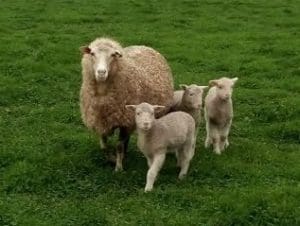
A Multimeat cross ewe at Elmore with triplet lambs.
A PUSH to have more fertile flocks is leading to more triplets, but making the most of these extra foetuses is the basis of a new research project.
Murdoch University in Western Australia is taking the lead on work which will determine the best ways to manage triplet-bearing ewes.
Murdoch University research officer Travis Allington is currently surveying producers across Western Australia, South Australia, Victoria, Tasmania and New South Wales who currently scan for triplets.
The survey, which will run over the next two years, will question 100 producers who currently scan for triplets and deferentially manage that flock, and 100 producers who have highly fertile flocks but don’t currently identify triplets.
“The surveys will focus on capturing current and historic data around survival of multiple bearing ewes and lambs.
“We will also ascertain farmers views on which management practices do and don’t work, in order to identify gaps in knowledge and barriers to adoption,” Mr Allington said.
The producers who are surveyed will be involved in workshops on triplet survival and future on-farm research, with the aim to build a network of producers who want to improve the management of their triplet-bearing ewes.
The information, combined with in-depth interviews with producers in Australia and New Zealand, will identify key management decisions which could affect triplet survival including:
condition score/liveweight targets at lambing,
feed-on-offer targets at lambing,
paddock allocation and mob size for lambing,
use of supplements in late pregnancy and for lambing,
ewe health (management of feet and internal parasites)
time of shearing in relation to lambing.
Research will then continue over the next two years at up to 70 sites across Australia.
“It is important that the project address what the farmers perceive as gaps and opportunities for them to improve their management to achieve better survival rates.
“This participatory research will develop and demonstrate best practice management strategies on commercial farms to build sheep producers ability and confidence to improve marking rates from triplet bearing ewes and their lambs,” Mr Allington said.
Mr Allington said the project was not trying to boost the level of triplets in a sheep flock, but as flocks became more fecund, triplets were unavoidable.
He said a flock scanning 120 percent would have 50pC lambs born as twins. A scanning percentage of 150pc meant 65-70pc of lambs would be born as twins and 5-10 per cent born as triplets. A scanning percentage of 180pc would mean more than 75pc of lambs born as twins and as much as 15pc born as triplets.
“This work we are doing is to work with farmers to achieve better outcomes from the triplets that already exist in their flocks,” he said.
“Triplet ewe and lamb survival in both Merinos and maternal breeds is highly variable, hence the need for this project.”
Anyone still wanting to be involved in the triplet project can contact Mr Allington on [email protected]

HAVE YOUR SAY